In mid October we took a week off from our life in the city to drive down the coast. In Spain they have different names for each little section of the coast. We drove along the Costa Dorado first on our way to Tarragona for lunch. This section is known for its many sandy beaches. Our destination this first day(Wednesday) was Morella. 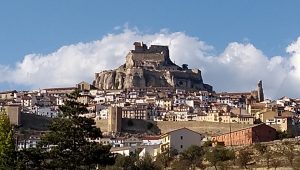
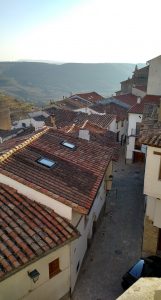
Morella is a little mountain village of about 2,500 people. The town suddenly appears around a corner and rises 1,000 meters above its surroundings. The walls around the town are well-preserved and are presided over by a castle. Only residents are allowed to drive into the old topmost part of the town. Hotel guests are allowed to drive in and drop off their luggage, but then must park outside the walls. Once again Google maps failed us as we ended up driving down a street so narrow that I didn’t think I could get through, and we had the smallest car we could rent! Roy got out and guided me past an entire block of scaffolding alongside a building. My gut feeling was that this was not right, we should not be driving here. And in fact half a block later that was confirmed as we reached a point where the street ended in stairs. Now came the really difficult part of having to turn around. There was a slightly wider place in the street where we turned around but made all the more unnerving by the fact that there were stairs going down and up on either side of the car! And to make matters worse, some residents came out of their houses to watch!
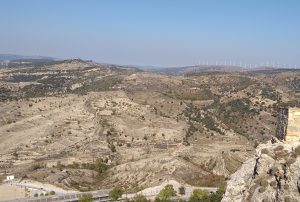
We did eventually find our hotel which was lovely. We could see a herd of sheep way down below our window and could hear the faint tinkling of their bells. The main street was lined with shops offering lots of locally produced cheese, honey and sausage. There were many unusual types of honey including oak and chestnut. We also saw some unique blankets reminiscent of Mexican patterns that Morella is well-known for. The next morning there was a small farmers market just down the street that I have since learned is a tradition stemming from the days of James I of Aragon in the 13th century! The next morning we hiked up to see the castle which offers a fantastic panoramic view of the countryside.
By early afternoon we were on our way to Valencia, but had a few more villages to visit on the way. We stopped off at Ares del Maestrat, which is built on the edge of a cliff. It is an ancient town with remains of Iberian culture as well as some remaining Arab walls. The Iberians were the indigenous people living in this area in the 8th to 6th centuries B.C. 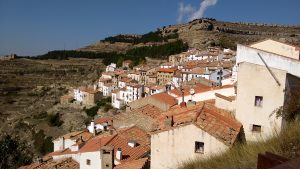 We followed a foot path around the village and then headed to the next village of Benasal. We heard that hazelnuts, or avellanas as they are known in Spain, were grown in this area. There was a big banner across the main street stating that October was avellana month. It was here in Benasal that we saw a huge pan of paella being served to the table next to us in a small cafe. There were nine men at that table and they couldn’t finish it!
We followed a foot path around the village and then headed to the next village of Benasal. We heard that hazelnuts, or avellanas as they are known in Spain, were grown in this area. There was a big banner across the main street stating that October was avellana month. It was here in Benasal that we saw a huge pan of paella being served to the table next to us in a small cafe. There were nine men at that table and they couldn’t finish it!
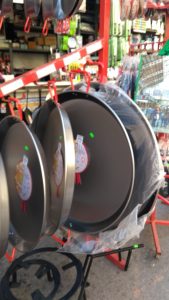
The coast around Valencia is known as the Costa del Azahar or the Orange Blossom Coast because of the miles and miles of orange groves. The land around Valencia is very flat and is where much rice is grown. It is home to Spain’s largest lake and wetland, the Albufera. There is a park along the edge of the lake that has some nice trails and bird watching areas.
Friday night we stayed at a lovely little hotel outside of Valencia a short distance and drove into town the next morning. They have rerouted the Turia River that ran through the city and turned the riverbed into a beautiful park. The city has built a very modern looking museum complex in the park known as the city of arts and sciences. We didn’t visit it on this trip but would like to in the future.
Saturday morning we drove down the Costa Blanca. This part of the coast is very popular with tourists and expat retirees from Europe.
We stopped by the small city of Denia for lunch and to walk a bit. We hiked up to the castle for some beautiful views of the city. You could see the port and the ferry to the Balearic Islands from the castle. Word is you can see the islands on a clear day, but we couldn’t.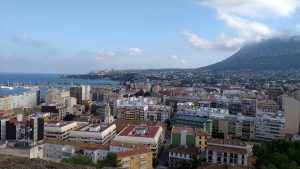 Then on to our destination for the day, Xàbia (or Jávea). There is an archaeological museum there that was free. We spent all the next morning there and I couldn’t help noticing the floors. The tiles were so beautiful and they reminded me of quilt squares.
Then on to our destination for the day, Xàbia (or Jávea). There is an archaeological museum there that was free. We spent all the next morning there and I couldn’t help noticing the floors. The tiles were so beautiful and they reminded me of quilt squares.
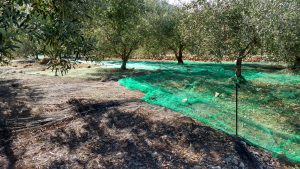
Roy had arranged to talk to some people in a little mountain village of Cocentaina in the afternoon, so we set off through some very dramatic scenery. Unfortunately, I am still stuck doing all the driving until Roy gets his driver’s license replaced. We drove past olive and orange orchards, vineyards and even saw pomegranates growing. This was a Sunday and we found that all the restaurants are closed on Sunday night. All we could find open to get a little food was a small halal market.
Monday we decided to drive inland and follow the Ruta del Vino for a while. First stop was Jumilla where it didn’t take long to find a wine tasting. Jumilla has its own DO (Denomination of Origin) for wine. We tried to find a restaurant for lunch and found that we had to wait until 2 p.m. for any to open. In the meantime, we thought we would go to the visitor information center. They were also closed for the afternoon. So we went in search of the town hall. There we found a lone police man who was very helpful. When we asked if there were any good restaurants in the area, he came alive and rhapsodized about the Casa Sebastián. This restaurant specializes in traditional Jumillan dishes. It was very good, although I tried not to look at Roy’s dish of Pig’s Ear Stew!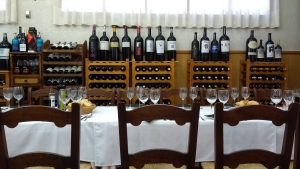
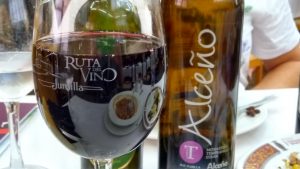
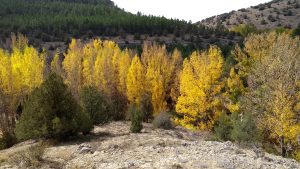
The next town on the route was Yecla, which also has its own DO. We just drove through since we were running a little short on time. Our destination this day was Almansa. This town has its own DO as well, and is also known for its shoe factories. There was a display of shoes and wine in our hotel lobby. They also make some world-class cheeses in the area. We tried a gold medal winning Manchego at dinner that night.
Tuesday we took a drive to Albarricín. Some say this little village in the far south of Aragón is one of the prettiest villages in Spain. All the houses are pink. There is a path called the “Paseo Fluvial” that goes all the way around the town and follows a little river as you might have guessed from the name. To go into the old town requires going up a steep flight of stairs or a steep road. We took the stairs. 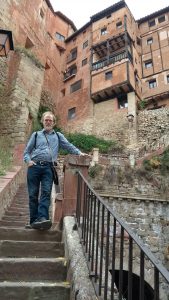
The next day was spent driving back to Barcelona in the rain. We are already thinking about where to go next!
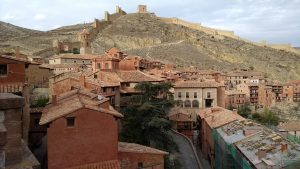
Since you didn’t mention it this time, and it seems you are doing well indeed, I imagine your Spanish lessons are paying off!
Well – I would say our Spanish is still extremely bad. A long uphill slog, but we are making progress… Every once in a while someone seems to understand us!